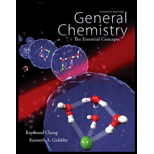
(a)
Interpretation:
The cell reaction for the given cell has to be found and a visual evidence has to be suggested to prove that
Concept Introduction:
Electrolytic cell is an
(b)
Interpretation:
The cell reaction for the given cell has to be found and a visual evidence has to be suggested to prove that
Concept Introduction:
Electrolytic cell is an electrochemical device in which electrical energy converted into chemical energy. A non-spontaneous chemical reaction is initiated by giving electrical energy to the cell. It has two electrodes, anode and cathode. Anode is having positive charge and at anode oxidation is taking place. Cathode is having negative charge and at cathode reduction takes place. The two electrodes are dipped in the same electrolyte.
(c)
Interpretation:
The cell reaction for the given cell has to be found and a visual evidence has to be suggested to prove that
Concept Introduction:
Electrolytic cell is an electrochemical device in which electrical energy converted into chemical energy. A non-spontaneous chemical reaction is initiated by giving electrical energy to the cell. It has two electrodes, anode and cathode. Anode is having positive charge and at anode oxidation is taking place. Cathode is having negative charge and at cathode reduction takes place. The two electrodes are dipped in the same electrolyte.
Want to see the full answer?
Check out a sample textbook solution
Chapter 19 Solutions
Package: General Chemistry with Connect 2-year Access Card
 ChemistryChemistryISBN:9781305957404Author:Steven S. Zumdahl, Susan A. Zumdahl, Donald J. DeCostePublisher:Cengage Learning
ChemistryChemistryISBN:9781305957404Author:Steven S. Zumdahl, Susan A. Zumdahl, Donald J. DeCostePublisher:Cengage Learning ChemistryChemistryISBN:9781259911156Author:Raymond Chang Dr., Jason Overby ProfessorPublisher:McGraw-Hill Education
ChemistryChemistryISBN:9781259911156Author:Raymond Chang Dr., Jason Overby ProfessorPublisher:McGraw-Hill Education Principles of Instrumental AnalysisChemistryISBN:9781305577213Author:Douglas A. Skoog, F. James Holler, Stanley R. CrouchPublisher:Cengage Learning
Principles of Instrumental AnalysisChemistryISBN:9781305577213Author:Douglas A. Skoog, F. James Holler, Stanley R. CrouchPublisher:Cengage Learning Organic ChemistryChemistryISBN:9780078021558Author:Janice Gorzynski Smith Dr.Publisher:McGraw-Hill Education
Organic ChemistryChemistryISBN:9780078021558Author:Janice Gorzynski Smith Dr.Publisher:McGraw-Hill Education Chemistry: Principles and ReactionsChemistryISBN:9781305079373Author:William L. Masterton, Cecile N. HurleyPublisher:Cengage Learning
Chemistry: Principles and ReactionsChemistryISBN:9781305079373Author:William L. Masterton, Cecile N. HurleyPublisher:Cengage Learning Elementary Principles of Chemical Processes, Bind...ChemistryISBN:9781118431221Author:Richard M. Felder, Ronald W. Rousseau, Lisa G. BullardPublisher:WILEY
Elementary Principles of Chemical Processes, Bind...ChemistryISBN:9781118431221Author:Richard M. Felder, Ronald W. Rousseau, Lisa G. BullardPublisher:WILEY





